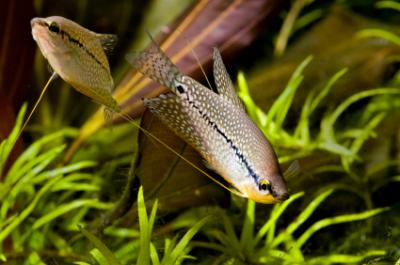Benefits of Aquatic Plants in the Aquarium

Aquatic plants could be the key to making your aquarium a success. Keeping a fish only aquarium can be hard, especially in the beginning where your aquarium is yet to establish its own natural eco-system. Plants can help combat early fish loss, by helping to purify your water making it safer for fish and shrimp. As well as providing benefits for your fish, plants help keep algae at bay and can be used to create stunning aquascapes. Let's look at the advantages in more detail to understand why aquatic plants can benefit your aquarium:
Aeration
During photosynthesis, plants use energy from a light source to convert H2O and CO2 into glucose to fuel the plants growth. Some oxygen is left over from this process which is released into the water, where it can be used by bacteria and your fish to survive. Exactly like in the wild, your planted aquarium will allow your fish to live and breathe from the oxygen released by your plants. Your plants release oxygen through their roots as well as their leaves, thus aerating your water column as well as your substrate. This is important in avoiding anaerobic spots underneath your substrate where bacterial colonies lay. Having aquatic plants therefore means an aeration unit is not often required in the planted aquarium. Your aquatic plants will do the work for you!
Water Purification
The initial stages of your aquarium start up can be dangerous for your fish and shrimp. Whilst the aquarium is naturally generating its own eco-system, known as the nitrogen cycle, toxin levels such as ammonia and nitrite are high. These toxins can be dangerous to fish and shrimp, therefore water changes need to be big and often during the early stages. Another way to help keep these toxins to a minimum is to add plants, which use the ammonia and nitrite as food to grow. This doesn't mean water changes become completely unnecessary; it means your plants will create a healthier environment for your fish. Often planted aquarists add fish and shrimp much earlier than those with a fish only tank.
Algae prevention
Algae can be a nuisance in most aquariums. It is also always present in an aquarium, whether you can see it or not. The objective is to keep the algae to a minimum (out of eyesight), not only for aesthetical purposes but for the benefit of fish and plant health. Just like plants, algae requires light and a source of food to survive. The one thing algae has over plants is it has the ability to survive on very little amounts, as long as there's light and a source of food, algae can survive.
One of the main triggers for algae is ammonia, it is therefore vital to keep levels of ammonia to a minimum. Plants can help combat algae by removing Ammonia. Ammonia is caused by the breakdown of organic waste, such as fish food, fish waste, and dead plant leaves. Faster growing plants such as stem plants have the ability to remove large amounts of ammonia quickly because of their rapid rate of growth. They are therefore favored in the initial stages of the aquarium in which the aquarium is "un-cycled" and there is not yet a sufficient amount of beneficial bacteria to convert ammonia into the much safer nitrate.
Aquascaping
The most enjoyable part of introducing plants to your aquarium has to be the aesthetical side. Aquascaping is a term used for creating underwater scenes or landscape using aquatic plants and hardscape (rocks, wood etc). Plants should be carefully chosen to cover all levels of the aquarium, from smaller plants for the foreground and larger plants in the background. Often in aquascaping, smaller fish are used such as Rasbora to create a sense of scale, making the aquascape appear larger. Pruning becomes on important part of aquarium maintenance in order to maintain the look/shape of your aquascape, as well as to encourage new growth or trying to encourage a plant to grow in a particular way.
Advice When Setting Up Your Planted Aquarium
- Change 25-50% of your water once per week. During the first 2-3 weeks try to do two weekly water changes to keep organic waste to a minimum.
- It's a good idea to keep your lighting period at 6 hours per day for the first 2-3 weeks.
- Start injecting CO2 from day one. If CO2 injection is not incorporated into your system, try using liquid carbon; a great alternative to CO2 injection if you're on a budget.
- Make sure you fertilize your water with plant food from day 1. It's a myth that fertilizers can cause trigger algae. In fact it's quite the opposite!
- I would recommend using some faster growing plants during your initial tanks setup, as this is an important way to reduce ammonia levels from the start. Try using the following plant species; Cabomba, Ludwigia or Egeria Densa. Similar stem species will be just as effective.
About the Author: David Pierce is the owner of the online aquarium plant specialist aquariumgardens.co.uk, where you can purchase high quality aquatic plants and have them delivered straight to your door! You can follow Aquarium Gardens on Google+, Twitter, and Facebook.
